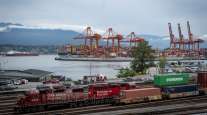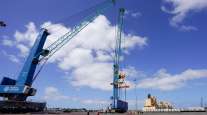Senior Reporter
Congestion, Slowdown at Ports Cause Growing Concern

[Ensure you have all the info you need in these unprecedented times. Subscribe now.]
Many of the nation’s ports, especially on the West Coast, are reporting long delays to unload cargo ships, and warehouses near those facilities are filled as the supply chains are overloaded with goods.
That is the result of retailers seeing a surge in e-commerce purchases and significant changes to spending patterns of U.S. consumers and businesses.
“It’s really the perfect storm,” supply chain and logistics expert Mirko Woitzik with Resilience360 said from Cologne, Germany, in an interview with Transport Topics.

Woitzik
“There are so many factors that are contributing to this. There are so many different interests between the truckers, the carriers, the port operators and then put the COVID situation into this, the huge demand, and the previous huge drop in demand six months ago. It’s not probably going to be solved until the Chinese New Year, in the middle of February 2021.”
Typically, then there’s a lull in shipping as factories in Southeast Asia shut down for several weeks.
The ongoing situation is a departure from the spring, when container volumes at ports dropped dramatically as the world economy plunged into a recession because of the coronavirus.
In the most recent monthly report from the major cargo ports, most facilities reported record or near-record container volumes. The Port of Los Angeles processed 980,729 20-foot-equivalent units in October, an 18% year-over-year increase from 770,289 TEUs. It also marked the port’s best month in its history.
Some in government and the trucking industry believe the ports’ delays go deeper than just an imbalance in the supply chain and the impact of the COVID-19 pandemic.
Propelled by replenishment of inventories and retailers preparing for upcoming holidays, October marked the busiest month in the Port of Los Angeles' 114-year history. Year to date, overall cargo volumes lag by 5.3% compared to 2019. https://t.co/nNiCbP58Bg pic.twitter.com/mnjvU9FB47 — Port of Los Angeles (@PortofLA) November 18, 2020
Federal Maritime Commissioner Carl Bentzel said he supports opening a fact-finding investigation into the two Southern California ports’ ongoing congestion issues. He also said there is a growing problem at the Port Authority of New York and New Jersey.
“I believe that we have deep-seated problems that could continue for the foreseeable future, and I strongly believe we must pay immediate attention to these issues,” Bentzel wrote. “The volume surges currently overtaking the ports of Los Angeles and Long Beach, and now New York and New Jersey, shine a light on the operational vulnerabilities and reveal our supply chain weaknesses.”
Weston LaBar, CEO of Long Beach-based Harbor Trucking Association, told Transport Topics his group has asked the international ocean carriers that move millions of tons of cargo into the ports to temporarily suspend detention and demurrage fees at the ports of Los Angeles and Long Beach until the congestion issues ease.
Demurrage fees are charged when a container is still full and under the shipping line’s control and has not been cleared through customs or picked up by the consignee. Detention costs incur for using equipment, such as a chassis, beyond the given free time and typically outside of the terminal.
LaBar said the major shipping companies and shipping alliances have the ability to slow down traffic at the ports to impact the amount of fees charged to trucking companies.
“We’re just asking for a fair playing field, that when a trucker cannot pick up a container, or drop off an empty or their export booking has been canceled,” LaBar said. “They should not be the ones on the hook, paying the penalty, because the ocean carrier made a decision that benefits paying the penalty, without any remorse on how it affects the other members of the supply chain.”
Meanwhile, so-called dwell time delays are worsening.
The Pacific Merchant Shipping Association said that in October containers remained at terminals at the two Southern California ports for nearly five days, the most prolonged average period since the group began tracking data in 2016.
An official with the Port of Los Angeles told TT the delays extend to the Pacific Ocean as well. On Dec. 1, 18 ships were anchored off the Southern California coast, with nine waiting for slots at the Port of Los Angeles and nine waiting for entry into the Port of Long Beach.
Phillip Sanfield, Port of Los Angeles director of communications, told TT that usually there might be one or two ships waiting to be routed into those facilities.
“There is a several-day waiting to unload cargo, at least,” he said. “We have a little more of a backlog now because of the Thanksgiving Day holiday, and we had less staff to unload cargo.”
However, there are ways for shippers to get cargo into the West Coast facilities, but it’s costly. Many ports operate express berths, so smaller cargo ships — those carrying less than 6,000 TEUs — can reserve spots for those ships that sail direct routes.
For example, the Port of Long Beach operates what’s called the C60 terminal, where ships using direct service from Guam, Hawaii and three locations from China (Shanghai, Ningbo and Xiamen) get priority service.
Want more news? Listen to today's daily briefing:
Subscribe: Apple Podcasts | Spotify | Amazon Alexa | Google Assistant | More




